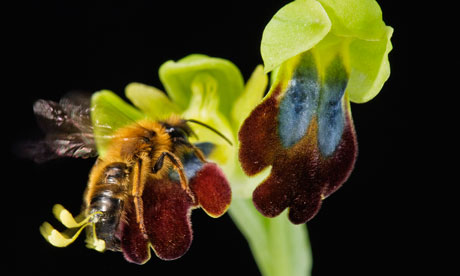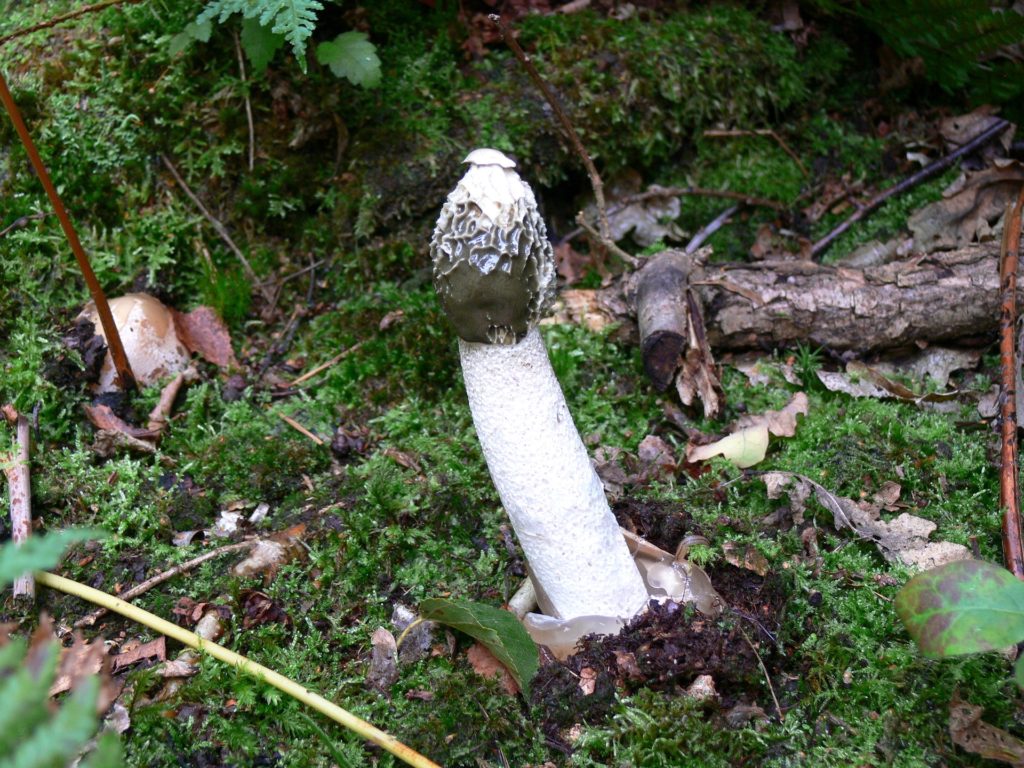
This is my last blog for a while on the fascinating topic of mimicry in animals and plants. Previously I wrote about Batesian and Müllerian mimicry in
Copycat Evolution and
More Mimetic Evolution where a harmless species comes to resemble a harmful one and so gains protection from a predator which has learned to avoid the harmful one (Batesian), or two harmful species come to resemble one another and so gain from the evolutionary 'spade-work' of the other (Müllerian).
Now I'm going to look at another form of mimicry where (usually) a plant deceives another species into thinking it's something else, not to repel or avoid it, but to attract it. Almost invariably this improves pollen or spore distribution so it's not hard to understand how any improvement in this system gave the plant an advantage and so natural selection favoured it.
Perhaps the most famous are the orchids which resemble female bees or wasps to attract males of the mimicked species which try to mate with them. In doing so, the bees pick up a packet of pollen (a pollinia) which they deposit on the stigma of the next flower they try to mate with. There is also selection pressure on the orchid to resemble their 'victims' more closely and other species less closely otherwise there would be a good probability of the pollen being carried to the wrong species. So, different species of orchid tend to specialise on one type of bee or wasp.
.jpg) |
| Mirror Bee Orchid - Ophrys speculum |
|
 |
| Bumblebee Orchid - Ophrys bomybliflora |
|
 |
| Sombre Bee-orchid - Ophrys fusca |
|
.jpg)
|
| Yellow Bee-orchid - Ophrys lutea |
|
| Source: Wikipedia - Ophrys |
 This is my last blog for a while on the fascinating topic of mimicry in animals and plants. Previously I wrote about Batesian and Müllerian mimicry in Copycat Evolution and More Mimetic Evolution where a harmless species comes to resemble a harmful one and so gains protection from a predator which has learned to avoid the harmful one (Batesian), or two harmful species come to resemble one another and so gain from the evolutionary 'spade-work' of the other (Müllerian).
This is my last blog for a while on the fascinating topic of mimicry in animals and plants. Previously I wrote about Batesian and Müllerian mimicry in Copycat Evolution and More Mimetic Evolution where a harmless species comes to resemble a harmful one and so gains protection from a predator which has learned to avoid the harmful one (Batesian), or two harmful species come to resemble one another and so gain from the evolutionary 'spade-work' of the other (Müllerian). .jpg)


.jpg)


 On the subject of scent mimicry, a common form is to imitate the smell of dung or rotting flesh to attract dung beetles and flies. The rotting flesh smell of the flowers of the Stapelia are so realistic that blowflies actually lay eggs on them.
On the subject of scent mimicry, a common form is to imitate the smell of dung or rotting flesh to attract dung beetles and flies. The rotting flesh smell of the flowers of the Stapelia are so realistic that blowflies actually lay eggs on them.



This is really a fascinating topic. You can look at the mimicry phenomenon from more than one angle. Here's another site dealing with, at least in part, the same sort of phenomena as you describe, Rosa: http://waynesword.palomar.edu/ww0602.htm .
ReplyDeleteBut at that site focus is more on homology and homoplasy.
A quote from that site: I prefer to use the terms homology and homoplasy when dicussing the evolution of similar characteristics. Homology refers to similarity due to a common ancestor. Characteristics derived from a common ancestor are termed homologous. Homologous organs are similar in structure and embryonic origin but are not necessarily similar in function. Cactus spines are homologous to bud scales of an axillary bud. Seed-bearing carpels of flowering plants are homologous to leaves because of their similarity in form, anatomy and development. The bone structure in the wings of a bat is homologous to the forelimbs of humans and other mammals. For example, a bat's wing and whale's flipper both originated from the forelimbs of early mammalian ancestors, but they have undergone different evolutionary modification to perform radically different tasks of flying and swimming. The penis and clitoris are also homologous organs. The presence of homology is evidence that organisms are related. Birds, bats and insects are not closely related and their wings are not homologous. Although they are all used for flight, they evolved independently in distantly related animals and are structurally quite different. Unrelated species with flowers that smell like carrion is not an example of homology because they are not closely related. They belong to very different and distantly related plant families. Stinking flowers in unrelated plant families is a good example of homoplasy or convergent [or parallel] evolution.
Read more about convergent or parallel evolution here: http://rosarubicondior.blogspot.se/2014/05/dna-shows-big-bird-evolution.html .
Here's a quote from that blog article: [B]ig flighteless birds like the emu, ostrich, moa, the extinct giant elephant bird or Aepyornis maximus of Madagascar, and not so big New Zealand kiwi, which we collectively call the ratities, (...) may not be closely related at all and may have evolved from flying birds on at least six different occasions. Their similar appearance may simply be an example of convergent evolution where broadly similar environments produce broadly similar solutions.
And here's an article especially for you, Rosa: http://msutoday.msu.edu/news/2014/evolutionary-compromises-drive-diversity/ .
ReplyDeleteThree quotes from that article: 1) Trade-offs, which are evolutionary compromises, drive the diversity of life, said Chris Adami, MSU professor of microbiology and molecular genetics.
2) “Trade-offs in biology can take many forms, but in general, they imply that organisms cannot optimize all traits at the same time,” said Bjorn Ostman, post-doctoral research associate in the Adami lab. In other words, they can’t have it all.
3) This reality is well known in the animal world. For example, in Madagascar, lemurs have evolved to eat different things, which ensures that there is enough food for all. Some lemur species eat fruit, but due to trade-offs, cannot eat leaves because their digestive tracts have become too short and cannot process the fiber. Other lemurs have long digestive tracts and can eat leaves, but they get sick from eating fruit because it ferments from staying in their guts too long.